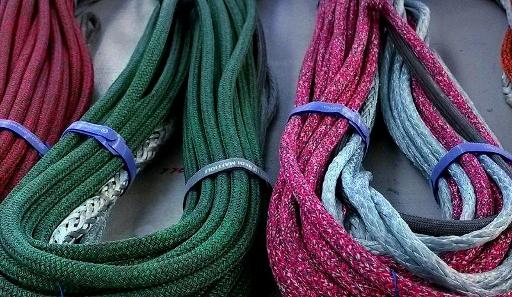The majority of sailing ropes are double braid construction i.e. with a core and braided cover. The purpose of this cover is to protect the core from general chafe, abrasion and UV damage but also to provide grip and durability of the line on winches and in clutches. Sailing ropes are manufactured in a uniform construction, but customisation is relatively quick, easy and inexpensive and adds a whole new dimension to optimising your running rigging. In this article we look at why, when and where to use cover stripping and re-covering techniques to improve your running rigging systems.
Why strip sailing ropes?
The term “stripping” of your sailing ropes means removing the outer braided cover to expose the core. Apart from reducing weight, stripping off the cover makes the line thinner which can significantly reduce friction in your running lines as they turn through blocks and sheaves. At the ends it also reduces the bulk of any splice which can be important if a halyard or sheet is being pulled tight into a sheave.
When to strip sailing ropes?
You need to ensure you have the correct sort of rope before you consider stripping your sailing lines. The majority of standard cruising lines use a polyester core and a polyester cover. In this double braid construction using the same materials, the cover is integral to the overall break strength of the line and therefore it is not advisable to remove the cover. A polyester core is also soft and easily damaged without the protective cover.
Most performance orientated lines these days have a Dyneema® core with covers made from all-sorts of specialist fibres used to improve grip or general handling depending on application. In these lines, there is a clear distinction between the role of the core, for strength, and the cover for handling characteristics. These lines are suitable for stripping.

Where to strip?
Sheets - Stripping the sail ends of jib and spinnaker sheets is very common as it reduces the weight in the sheets, which is a big benefit in lighter winds. It also reduces windage and improves the speed and efficiency of the lines running through the system during tacks and jibes.
Halyards are most often stripped between the sheave at the top of the rig and the halyard exit at the bottom of the mast (in full hoist position). This is primarily for weight saving. Stripping any more than this and you would not be making friends with your mast man who would run off the end of the cover when hauling the halyard from the mast!
The general rule is not to strip any area which is being pulled by hand, turned around a winch or located in a clutch or jammer.
Managing the downside
The compromise with stripping is that you are exposing the core of the rope to potential chafe and UV. A performance solution to this can be to actually “re-cover” the stripped core with a thin Dyneema® cover. It might sound crazy to strip one cover off and put another cover on, but this is a very common practice. A pure Dyneema® cover will offer excellent chafe resistance, low friction, and all at a fraction of the weight of the original cover.

For example, at the sail end of a halyard, the original cover can be stripped off completely, down to the halyard exit at the bottom of the mast. A short length (2m) of Dyneema® cover can then be added to protect against chafe at the sheave.
On sheets and guys, having stripped back the original cover to where the line loads on the winch, it is often advisable to re-cover the full exposed length.
It is worth noting that some specialist lines have an extra durable core, specifically for the purpose of stripping without the addition of a Dyneema® cover. One example would be Gottifredi Maffioli Superswift, a favourite among Performance dinghy sailors. You can read more about superswift line here.
What about all that wasted cover?
All sailing ropes find a second use after their original service life and those stripped off pieces of cover are no different. Loose pieces of cover with no core make excellent sail ties with a simple eye and a whipping. The same configuration also lends itself neatly to a dog leash!
Summary on sailing ropes
Modern performance ropes rely on the core for strength and covers are becoming increasingly technical but primarily focussed on performance on winches and in jammers, which is only a relatively small proportion of the overall line length. Therefore, stripping and recovering using thin Dyneema® covers provides significant opportunities for optimisation of your running rigging package.
If you have any questions about sailing ropes, please feel free to email us at [email protected], or click the link below to see our full range:


Stripping and recovering sailing ropes – when, where and why?